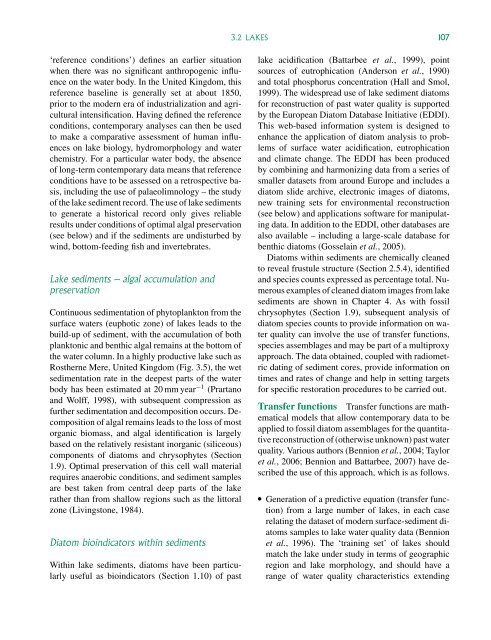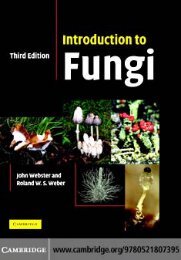Freshwater Algae: Identification and Use as Bioindicators
Freshwater Algae: Identification and Use as Bioindicators
Freshwater Algae: Identification and Use as Bioindicators
Create successful ePaper yourself
Turn your PDF publications into a flip-book with our unique Google optimized e-Paper software.
3.2 LAKES 107‘reference conditions’) defines an earlier situationwhen there w<strong>as</strong> no significant anthropogenic influenceon the water body. In the United Kingdom, thisreference b<strong>as</strong>eline is generally set at about 1850,prior to the modern era of industrialization <strong>and</strong> agriculturalintensification. Having defined the referenceconditions, contemporary analyses can then be usedto make a comparative <strong>as</strong>sessment of human influenceson lake biology, hydromorphology <strong>and</strong> waterchemistry. For a particular water body, the absenceof long-term contemporary data means that referenceconditions have to be <strong>as</strong>sessed on a retrospective b<strong>as</strong>is,including the use of palaeolimnology – the studyof the lake sediment record. The use of lake sedimentsto generate a historical record only gives reliableresults under conditions of optimal algal preservation(see below) <strong>and</strong> if the sediments are undisturbed bywind, bottom-feeding fish <strong>and</strong> invertebrates.Lake sediments – algal accumulation <strong>and</strong>preservationContinuous sedimentation of phytoplankton from thesurface waters (euphotic zone) of lakes leads to thebuild-up of sediment, with the accumulation of bothplanktonic <strong>and</strong> benthic algal remains at the bottom ofthe water column. In a highly productive lake such <strong>as</strong>Rostherne Mere, United Kingdom (Fig. 3.5), the wetsedimentation rate in the deepest parts of the waterbody h<strong>as</strong> been estimated at 20 mm year −1 (Prartano<strong>and</strong> Wolff, 1998), with subsequent compression <strong>as</strong>further sedimentation <strong>and</strong> decomposition occurs. Decompositionof algal remains leads to the loss of mostorganic biom<strong>as</strong>s, <strong>and</strong> algal identification is largelyb<strong>as</strong>ed on the relatively resistant inorganic (siliceous)components of diatoms <strong>and</strong> chrysophytes (Section1.9). Optimal preservation of this cell wall materialrequires anaerobic conditions, <strong>and</strong> sediment samplesare best taken from central deep parts of the lakerather than from shallow regions such <strong>as</strong> the littoralzone (Livingstone, 1984).Diatom bioindicators within sedimentsWithin lake sediments, diatoms have been particularlyuseful <strong>as</strong> bioindicators (Section 1.10) of p<strong>as</strong>tlake acidification (Battarbee et al., 1999), pointsources of eutrophication (Anderson et al., 1990)<strong>and</strong> total phosphorus concentration (Hall <strong>and</strong> Smol,1999). The widespread use of lake sediment diatomsfor reconstruction of p<strong>as</strong>t water quality is supportedby the European Diatom Datab<strong>as</strong>e Initiative (EDDI).This web-b<strong>as</strong>ed information system is designed toenhance the application of diatom analysis to problemsof surface water acidification, eutrophication<strong>and</strong> climate change. The EDDI h<strong>as</strong> been producedby combining <strong>and</strong> harmonizing data from a series ofsmaller dat<strong>as</strong>ets from around Europe <strong>and</strong> includes adiatom slide archive, electronic images of diatoms,new training sets for environmental reconstruction(see below) <strong>and</strong> applications software for manipulatingdata. In addition to the EDDI, other datab<strong>as</strong>es arealso available – including a large-scale datab<strong>as</strong>e forbenthic diatoms (Gosselain et al., 2005).Diatoms within sediments are chemically cleanedto reveal frustule structure (Section 2.5.4), identified<strong>and</strong> species counts expressed <strong>as</strong> percentage total. Numerousexamples of cleaned diatom images from lakesediments are shown in Chapter 4. As with fossilchrysophytes (Section 1.9), subsequent analysis ofdiatom species counts to provide information on waterquality can involve the use of transfer functions,species <strong>as</strong>semblages <strong>and</strong> may be part of a multiproxyapproach. The data obtained, coupled with radiometricdating of sediment cores, provide information ontimes <strong>and</strong> rates of change <strong>and</strong> help in setting targetsfor specific restoration procedures to be carried out.Transfer functions Transfer functions are mathematicalmodels that allow contemporary data to beapplied to fossil diatom <strong>as</strong>semblages for the quantitativereconstruction of (otherwise unknown) p<strong>as</strong>t waterquality. Various authors (Bennion et al., 2004; Tayloret al., 2006; Bennion <strong>and</strong> Battarbee, 2007) have describedthe use of this approach, which is <strong>as</strong> follows. Generation of a predictive equation (transfer function)from a large number of lakes, in each c<strong>as</strong>erelating the dat<strong>as</strong>et of modern surface-sediment diatomssamples to lake water quality data (Bennionet al., 1996). The ‘training set’ of lakes shouldmatch the lake under study in terms of geographicregion <strong>and</strong> lake morphology, <strong>and</strong> should have arange of water quality characteristics extending
















